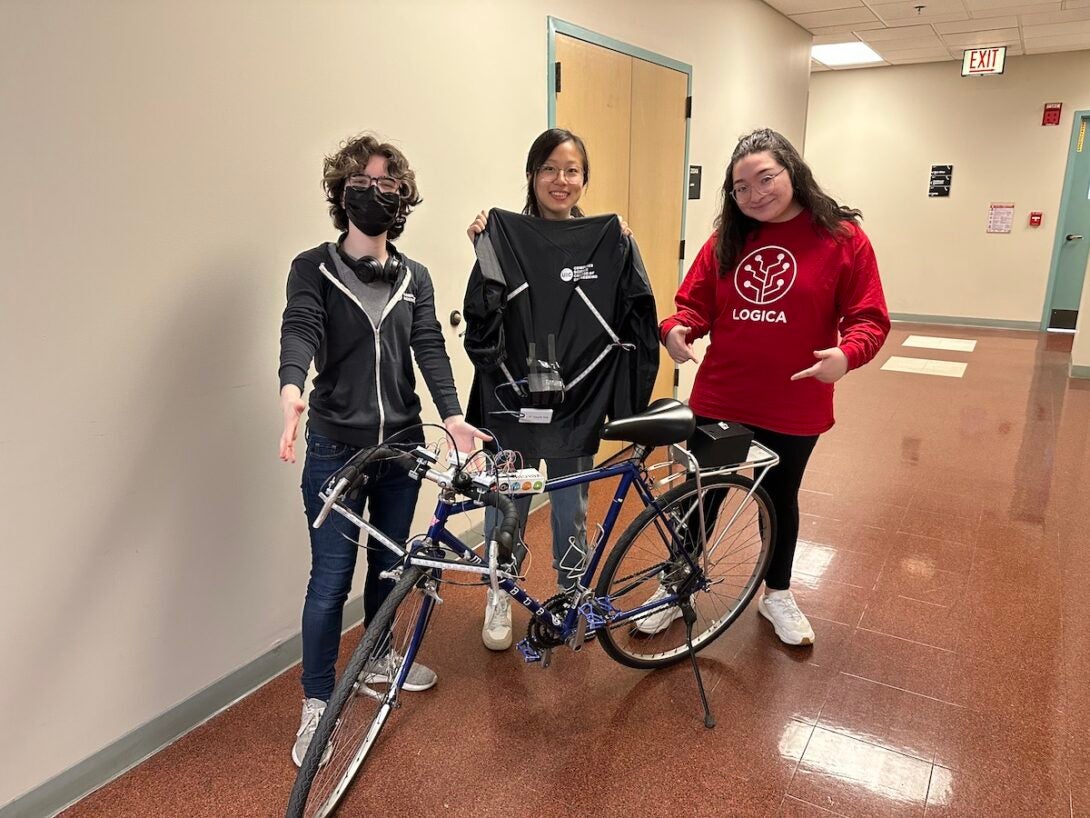Expo team creates winning design to make biking safer
Expo team creates winning design to make biking safer

Emily Mendoza, Polly Ruhnke, and Annie You, all cyclists, know the dangers of biking in and around the city, especially at night, and wanted a tool to improve their safety and visibility when riding. While commercial products are available for this purpose, they can be pricey–especially for students.
The trio decided to build their own tool, which earned them a win at UIC’s Engineering Expo. Their system, Lite-Bike, was created as the final project for the required class Computer Design (CS 362). At Expo, UIC alumni and other experts serve as judges, evaluating all student entries.
“We wanted to create something super fun and simple to use,” Mendoza said. “I wanted to show it’s possible using something as simple as an Arduino Uno.”
Arduinos are minicomputers, consisting of a programmable circuit board and a piece of software to write and upload computer code to the physical board. The Lite-Bike comprises turn signals activated by the rider and includes both front signals along the handlebars, and rear signals attached to the back of a jacket worn by the rider. A gyro sensor, which detects angular velocity, is mounted at the rear of the bike and serves as a crash detection system triggering flashing red lights to warn passersby of a downed, possibly injured, rider.
“I was new to Arduino and learned a lot of Arduino coding, and how to solder the LEDs,” Ruhnke said. “The more we worked, the more passionate we got about this project.”
You said one of the biggest surprises was the project planning stage versus the building stage: the cables that weren’t long enough, or the need to move items from their planned location to avoid other parts. They initially secured pieces with tape and rubber bands, then Mendoza built 3D plastic casings in UIC’s Makerspace to contain the electronics, relying on computer-aided design (CAD) skills she picked up in her Program Design course, CS 111.
Mendoza, Ruhnke, and You said the project was especially rewarding because of how well they all get along.
Mendoza, a sophomore, grew up in Chicago and is an avid cyclist. She was very familiar with UIC prior to her decision to attend, participating in the Girls Who Code at UIC club in high school. She knew the school offered a supportive environment and is a Hispanic Serving Institution. Mendoza serves on the board of LOGICA, a group looking to increase the participation and success of students from Latinx and underrepresented communities in computing and computer science. This summer, Mendoza will return to Amazon headquarters in Seattle, for her second summer internship in their financial tech division.
Ruhnke, a junior, lives in the suburbs of Chicago. She and her twin sister both attend UIC. Ruhnke chose UIC for its computer science program and the opportunities the university provides. She participated in UIC’s Break Through Tech Chicago Sprinternships program, a three-week mini internship at CVS. They offered her the opportunity to return this summer, but she is looking for a local opportunity related to her major.
You was attracted to UIC for the diversity, citing their mixed background, and growing up in Mexico as a child of Chinese parents. This summer, they will spend ten weeks interning with AT&T in New Jersey in the company’s cybersecurity offices. You previously participated in a Sprinternship with Cisco and took part in UIC’s Freshman Guaranteed Paid Internship Program.
The team thinks that cyclists can appreciate the functionality of their project.
“I wish everyone on the road in Chicago was required to bike for a few hours prior to obtaining a driver’s license,” Mendoza said. “People will park in bike lanes, or yell at bicyclists for being on the street even though that’s legal. This is a tool to keep people safer.”
Elijah Parr, a teaching assistant for the CS 362 class, was impressed with their system. In addition to the safety aspect for individual users of the Lite-Bike system, he sees commercial potential.
The Lite-Bike system cost about $30 to produce, and the sensors can be purchased for about half that amount, Parr said. He sees the system as something a bike share company such as Divvy could employ, monitoring crashes across bike share users.
“In Program Design II (CS 141), all the students do a project called Divvy Data; which contains ridership data for Divvy subscribers. That includes where the user is going, where they picked up the bike, where they stopped, how far they went, and how many rides they have,” Parr said. “I believe that the test file contains about two million data points.”